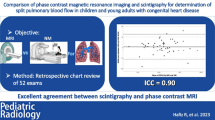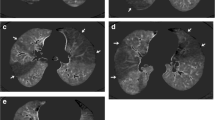Abstract
Background: Lung perfusion scintigraphy is considered the gold standard to assess differential pulmonary blood flow while magnetic resonance (MR) has been shown to be an accurate alternative in some studies. Objective: The purpose of the study was to assess the accuracy of phase contrast magnetic resonance (PC-MR) in measuring pulmonary blood flow ratio compared with lung perfusion scintigraphy in patients with complex pulmonary artery anatomy or pulmonary hypertension and to document reasons for discrepant results. Materials and methods: We identified 25 cases of congenital heart disease between January 2000 and 2003, in whom both techniques of assessing pulmonary blood flow were performed within a 6-month period without an interim surgical or transcatheter intervention. The study group included cases with branch pulmonary artery stenosis, intracardiac shunts, single ventricle circulation, pulmonary venous anomalies and conotruncal defects. The mean age at study was 5.7 years (range 0.33–12) with a mean weight of 20.3 kg (range 6.5–53.6). The two methods were compared using a Bland-Altman analysis, and the Pearson correlation coefficient was calculated using the lung scan as the gold standard. Discrepant results were examined by reviewing the source images to elucidate reasons for error by MR. Results: Bland-Altman analysis comparing right pulmonary artery (RPA) blood flow percentage, as measured by each modality, showed a mean difference of 1.43±9.8 (95% limits of agreement: −17.8, 20.6) with a correlation coefficient of r=0.84, P<0.0001. In six (24%) cases a large difference (>10%) was found with a mean difference between techniques of 17.9%. The reasons for discrepant results included MR artifacts, dephasing owing to turbulent flow, site of data acquisition and lobar lung collapse. Conclusion: When using PC-MR to assess pulmonary blood flow ratio, important technical errors occur in a significant proportion of patients who have abnormal pulmonary artery anatomy or pulmonary hypertension. If these technical errors are avoided, PC-MR is able to supply both anatomic and quantitative functional information in this patient population.






Similar content being viewed by others
References
Pruckmayer M, Zacherl S, Salzer-Muhar U, et al (1999) Scintigraphic assessment of the pulmonary and whole-body blood flow patterns after surgical intervention in congenital heart disease. J Nucl Med 40:1477–1483
Wiles HB (1998) Nuclear cardiology. In: Garson A Jr, Bricker JT, Fisher DJ, et al (eds) The science and practice of pediatric cardiology, 2nd edn. Williams and Wilkins, Baltimore, pp 889–906
Vick GW III, Rokey R, Huhta JC, et al (1990) Nuclear magnetic resonance imaging of the pulmonary arteries, subpulmonary region, and aortopulmonary shunts: a comparative study with two-dimensional echocardiography and angiography. Am Heart J 119:1103–1110
Underwood SR, Firmin DN, Klipstein RH, et al (1987) Magnetic resonance velocity mapping: clinical application of a new technique. Br Heart J 57:404–412
Caputo GR, Kondo C, Masui T, et al (1991) Right and left lung perfusion: in vitro and in vivo validation with oblique-angle, velocity-encoded cine MR imaging. Radiology 180:693–698
Kim JH, Lee DS, Chung JK, et al (1996) Quantitative lung perfusion scintigraphy in postoperative evaluation of congenital right ventricular outflow tract obstructive lesions. Clin Nucl Med 21:471–476
Reich O, Horvath P, Ruth C, et al (1996) Pulmonary blood supply in bidirectional cavopulmonary anastomosis with pulsatile pulmonary blood flow: quantitative analysis using radionuclide angiocardiography. Heart 75:513–517
Dowdle SC, Human DG, Mann MD (1990) Pulmonary ventilation and perfusion abnormalities and ventilation perfusion imbalance in children with pulmonary atresia or extreme tetralogy of Fallot. J Nucl Med 31:1276–1279
Houzard C, Andre M, Guilhen S, et al (1989) Perfusion lung scan in patients operated for transposition of the great arteries. Clin Nucl Med 14:268–270
del Torso S, Milanesi O, Bui F, et al (1988) Radionuclide evaluation of lung perfusion after the Fontan procedure. Int J Cardiol 20:107–116
Lin CY (1971) Lung scan in cardiopulmonary disease. I. Tetralogy of Fallot. J Thorac Cardiovasc Surg 6:370–379
Kang I, Redington AN, Benson LN, et al (2003) Differential regurgitation in branch pulmonary arteries after repair of tetralogy of Fallot. A phase contrast cine magnetic resonance study. Circulation 107:2938–2943
Greil G, Geva T, Maier SE, et al (2002) Effect of acquisition parameters on the accuracy of velocity encoded cine magnetic resonance imaging blood flow measurements. J Magn Reson Imaging 15:47–54
Boothroyd AE, McDonald EA, Carty H (1996) Lung perfusion scintigraphy in patients with congenital heart disease: sensitivity and important pitfalls. Nucl Med Commun 17:33–39
Powell AJ, Maier SE, Chung T, et al (2000) Phase-velocity cine magnetic resonance imaging measurement of pulsatile blood flow in children and young adults: in vitro and in vivo validation. Pediatr Cardiol 21:104–110
Paz R, Mohiaddin RH, Longmore DB (1993) Magnetic resonance assessment of the pulmonary arterial trunk anatomy, flow, pulsatility and distensibility. Eur Heart J 14:1524–1530
Morgan VL, Roselli RJ, Lorenz CH (1998) Normal three-dimensional pulmonary artery flow determined by phase contrast magnetic resonance imaging. Ann Biomed Eng 26:557–566
Pedersen EM, Stenbog EV, Frund T, et al (2002) Flow during exercise in the total cavopulmonary connection measured by magnetic resonance velocity mapping. Heart 87:554–558
Cheng CP, Herfkens RJ, Lightner AL, et al (2004) Blood flow conditions in the proximal pulmonary arteries and vena cavae in healthy children during upright seated rest and cycling exercise, quantified with MRI. Am J Physiol Heart Circ Physiol
Silverman JM, Julien PJ, Herfkens RJ ,et al (1993) Quantitative differential pulmonary perfusion: MR imaging versus radionuclide lung scanning. Radiology 189:699–701
Be’eri E, Maier SE, Landzberg MJ, et al (1998) In vivo evaluation of Fontan pathway flow dynamics by multidimensional phase-velocity magnetic resonance imaging. Circulation 98:2873–2882
Migliavacca F, Kilner PJ, Pennati G, et al (1999) Computational fluid dynamic and magnetic resonance analyses of flow distribution between the lungs after total cavopulmonary connection. IEEE Trans Biomed Eng 46:393–399
Migliavacca F, Dubini G, Bove EL, et al (2003) Computational fluid dynamics simulations in realistic 3-D geometries of the total cavopulmonary anastomosis: the influence of the inferior caval anastomosis. J Biomech Eng 125:805–813
Fratz S, Hess J, Schwaiger M, et al (2002) More accurate quantification of pulmonary blood flow by magnetic resonance imaging than by lung perfusion scintigraphy in patients with Fontan circulation. Circulation 106(17):1510–1513
Author information
Authors and Affiliations
Corresponding author
Rights and permissions
About this article
Cite this article
Roman, K.S., Kellenberger, C.J., Farooq, S. et al. Comparative imaging of differential pulmonary blood flow in patients with congenital heart disease: magnetic resonance imaging versus lung perfusion scintigraphy. Pediatr Radiol 35, 295–301 (2005). https://doi.org/10.1007/s00247-004-1344-z
Received:
Revised:
Accepted:
Published:
Issue Date:
DOI: https://doi.org/10.1007/s00247-004-1344-z




